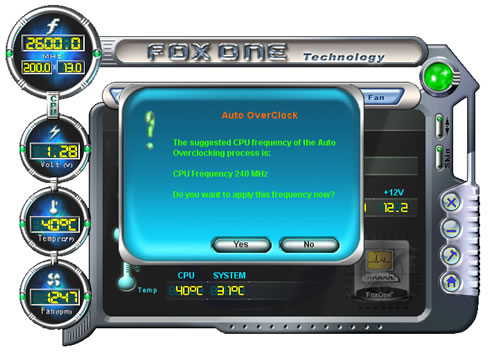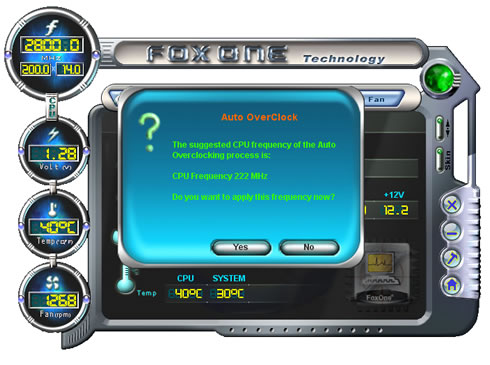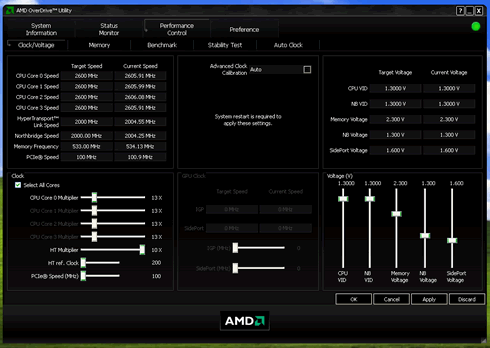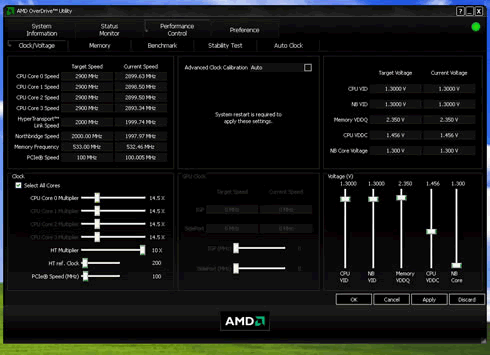AMD 790GX Roundup
12. The ATI 3300 IGP
Review Pages
2. Gigabyte MA790GP-DS4H
3. BIOS - Gigabyte MA790GP-DS4H
4. Foxconn A7DA-S
5. BIOS - Foxconn A7DA-S
6. Tests Setup
7. Benchmarks - Everest Ultimate Edition, SiSoftware Sandra
8. Benchmarks - PCMark Vantage, SYSmark 2007 Preview
9. Benchmarks - MAXON CINEBENCH, x264 HD Benchmark, TMPGEnc 4 Xpress
10. Benchmarks - SuperPI, wPrime
11. Overclocking
12. The ATI 3300 IGP
13. ATI 3300 - Gaming results
14. ATI 3300 - Video Playback tests
15. Final words
16. Benchmarks - 3DMark06, Crysis v1.2, Unreal Tournament 3 SYSmark 2007 Preview
Both motherboards are supposed to deliver good overclocking levels since they are based on the AMD 790GX platform. The Foxconn motherboards offer the "Foxconn one" software for overclocking under Windows. Although the software works well ,it doesn't offer much control over tweaking. For example, you cannot change the CPU multiplier under Windows, so you have to go under BIOS via a reboot procedure. The same applies to the Gigabyte motherboard with the EasyTune 6 software. Things here are less complicated; we have a better interface but again a few tweaking options. Fortunately for us, AMD has introduced an overclocking/tweaking software called "AMD Overdrive" that can be used for all AMD-based motherboards.
After launching the AMD Overdrive, we got a message warned us that overclocking might damage our hardware. No worries here, just press "OK" and continue:-).
The software's overall layout is very good and each tab has its own purpose. For example in the "system information" we can get info about our (sub)system, the status monitor reports temperatures and voltages while in the Performance control we can set all the major functions.
The Performance control has several other sub-tabs, such as the Clock/Voltage, Memory, Performance, Stability Test and Auto Clock.
First of all, enable the Advanced Clock Calibration, which was disabled by default. In our case we left it at "Auto".
The first problem we encountered was when we tried to set the CPU voltage. With the Gigabyte MA790GP-DS4H, you cannot set the Vcore under Windows, either with AMD Overdrive or Gigabyte's EasyTune 6 software. That was a little frustrating. So back to the BIOS and after setting Vcore around 1.45V we loaded Windows.
Let's launch AMD Overdrive and try to make some quick tests. Since our processor had its CPU multiplier unlocked, we simply dragged the CPU multiplier slider up until we find a stable point (via Prime95 software). The Gigabyte MA790GP-DS4H easily reached the 3.10GHz without any other tweaking.
On the other hand, the Foxconn A7DA-S showed a slightly different behavior. Here we could set the Vcore via the AMD Overdrive. We also noticed that the Memory voltage set under BIOS (2.30V) were different that what the AMD Overdrive software set (2.40V). Anyway we set the Vcore at 1.45V and we continued with the same procedure. The Foxconn A7DA-S had a lower performance and our CPU reached the 2.90GHz. We believe that Foxconn could improve the overall performance/compatibility with the AMD Overdrive software.
The Foxconn FoxOne software also offers "Auto overclock" tests, which allow you to set the the maximum FSB in case you decide to overclock without changing the CPU multiplier. With the default 13X multiplier, we got a 240MHz (~3.120GHz)

While with the 14X multiplier, we got a 222MHz (~3.108GHz).

We should note here that the results depend on your processor and the Vcore value. For example, the Foxconn motherboard reached the 3.10GHz but it wasn't very stable, even with the Vcore set at 1.50V. We assume that a more efficient cooling system here could help reduce the overall produced heat and improve stability.
Here are some heat numbers we got with the Scyth Mugen cpu cooler at various speeds:
- 2.90ghz (200x14.5x) 50 Celsius 1.46V
- 3.00ghz (200x15x) 54 Celsius 1.46V
- 3.10ghz (200x15.5x) 62 Celsius 1.504V
For sure both motherboards are ready to be explored via the AMD Overdrive software.
- Overclocking stability
Both motherboards showed more-or-less the same overclocking stability. After serious overclocking attempts, the system was able to post back and report a failed overclocking. In rare cases, we had to use a jumper and clear CMOS in order to get a working POST message.
Review Pages
2. Gigabyte MA790GP-DS4H
3. BIOS - Gigabyte MA790GP-DS4H
4. Foxconn A7DA-S
5. BIOS - Foxconn A7DA-S
6. Tests Setup
7. Benchmarks - Everest Ultimate Edition, SiSoftware Sandra
8. Benchmarks - PCMark Vantage, SYSmark 2007 Preview
9. Benchmarks - MAXON CINEBENCH, x264 HD Benchmark, TMPGEnc 4 Xpress
10. Benchmarks - SuperPI, wPrime
11. Overclocking
12. The ATI 3300 IGP
13. ATI 3300 - Gaming results
14. ATI 3300 - Video Playback tests
15. Final words
16. Benchmarks - 3DMark06, Crysis v1.2, Unreal Tournament 3 SYSmark 2007 Preview
























